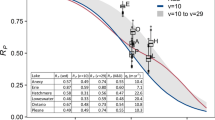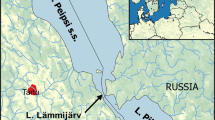Abstract
A lake is a product of processes in its watershed, and these relationships should be empirically quantifiable. Yet few studies have made that attempt. This study quantifies and ranks variables of significance to predict annual mean values of total phosphorus (TP) in small glacial lakes. Several new empirical models based on water chemistry variables, on ‘map parameters’ of the lake and its catchment, and combinations of such variables are presented. Each variable provides only a limited (statistical) explanation of the variation in annual mean values of TP among lakes. The models are markedly improved by accounting for the distribution of the characteristics (e.g., the mires) in the watershed. The most important map parameters were the proportion of the watershed lying close to the lake covered by rocks and open land (as determined with the drainage area zonation method), relief of the drainage area, lake area and mean depth. These empirical models can be used to predict annual mean TP but only for lakes of the same type. The model based on ‘map parameters’ (r 2=0.56) appears stable. The effects of other factors/variables not accounted for in the model (like redox-induced internal loading and anthropogenic sources) on the variation in annual mean TP may then be estimated quantitatively by residual analysis. A new mixed model (which combines a dynamic mass-balance approach with empirical knowledge) was also developed. The basic objective was to put the empirical results into a dynamic framework, thereby increasing predictive accuracy. Sensitivity tests of the mixed model indicate that it works as intended. However, comparisons against independent data for annual mean TP show that the predictive power of the mixed model is low, likely because crucial model variables, like sedimentation rate, runoff rate, diffusion rate and precipitation factor, cannot be accurately predicted. These model variables vary among lakes, but this mixed model, like most dynamic models, assumed that they are constants.
Similar content being viewed by others
References
Ahlgren, I., T. Frisk & L. Kamp-Nielsen, 1988. Empirical and theoretical models of phosphorus loading, retention and concentration vs. lake trophic state. Hydrobiologia 170: 285–303.
Andersson, T., Å., Nilsson, L. Håkanson & L. Brydsten, 1987. Mercury in Swedish lakes (In Swedish). SNV Report 3291, 92 pp.
Bierman, V.J.Jr., 1980. A comparison of models developed for phosphorus management in the Great Lakes. In: Loehr, C., Martin, C.S. and Rast, W. (eds), Phosphorus Management Strategies for Lakes pp. 235–255. Ann Arbor Science Publishers, Ann Arbor.
Busch, W. -D. N. & P. G. Sly (eds), 1992. The development of an aquatic habitat classification system for lakes. CRC Press, Boca Raton.
Chapra, S. C. & K. Reckhow, 1983. Engineering approaches for lake management. Vol. 2. Mechanistic modelling. Butterworth, Woburn, Mass.
Dillon, P. J. & F. H. Riegler, 1974. A test of a simple nutrient budget model predicting the phosphorus concentration in lake water. J. Fish. Res. Board Can. 31: 1771–1778.
Dillon, P. J. & F. H. Rigler, 1975. A simple method for predicting the capacity of a lake for development based on lake trophic status. J. Fish. Res. Board Can. 32: 1519771–1531.
Einsele, W., 1936. Über die Beziehungen des Eisenkreislaufs zum Phosphatkreislauf im eutrophen See. Arch. Hydrobiol. 29: 664–686.
Einsele, W., 1937. Physikalisch-chemische Betrachtung einiger Probleme des limnischen Mangan- und Eisenkreislaufs. Verh. Int. Ver. Limnol. 5: 69–84.
Einsele, W., 1938. Über chemische and kolloidchemische Vorgänge in Eisen-Phosphat-Systemen unter limnologischen und limnogeologischen Gesichtspunkten. Arch. Hydrobiol. 33: 361–387.
Håkanson, L., 1977. The influence of wind, fetch and water depth on the distribution of sediments i Lake Vänem, Sweden. Can. J. Earth Sci. 14: 397–412.
Håkanson, L., 1982. Lake bottom dynamics and morphometry — the dynamic ratio. Wat. Res. Res. 18: 1444–1450.
Håkanson, L., 1991. Ecometric and dynamic modelling-exemplified by cesium in lakes after Chernobyl. Springer-Verlag, Berlin, 158 pp.
Håkanson, L., 1992. Considerations on representative water quality data. Int. Rev. ges. Hydrobiol. 77: 497–505.
Håkanson, L. & M. Jansson, 1983. Principles of Lake Sedimentology. Springer-Verlag, Berlin, 316 pp.
Håkanson, L., Å Nilsson & T. Andersson, 1988. Mercury in fish in Swedish lakes. Env. Poll. 48: 145–162.
Håkanson, L., T. Andersson & Å Nilsson, 1990a. A new method of quantitatively describing drainage areas. Env. Geol. and Water Sci. 15: 61–69.
Håkanson, L., H. Borg & R. Uhrberg, 1990b. Reliability of analyses of Hg, Fe, Ca, K, P, pH, alkalinity, conductivity, hardness and colour from lakes. Int. Rev. ges. Hydrobiol. 75: 79–94.
Håkanson, L. & T. Andersson, 1992. Remedial measures against radioactive caesium in Swedish lake fish after Chernobyl. Aquatic Sci. 54: 141–164.
Håkanson, L. & R. H. Peters, 1994. Predictive limnology — a methodological textbook for predictive modelling. Manuscript, Uppsala Univ., 765 pp.
Jörgensen, S. E., L. Kamp-Nielsen & L. A. Jörgensen, 1986. Examination of the generality of eutrophication models. Ecological Modelling, 32: 251–266.
Lerman, A. (ed.), 1979. Lakes — it Chemistry, Geology, Physics. Springer-Verlag, Heidelberg, 363 pp.
Mortimer, C. H., 1941. The exchange of dissolved substances between mud and water in lakes. I. J. Ecol. 29: 280–329.
Mortimer, C. H., 1942. The exchange of dissolved substances between mud and water in lakes. II. J. Ecol. 30: 147–201.
Nicholls, K. H. & P. J. Dillon, 1978. An evaluation of phosphorus-chlorophyll-phytoplankton relationships for lakes. Int. Revue Ges. Hydrobiol. 63: 141–154.
Nilsson, Å. & L. Håkanson, 1992. Relationship between drainage area characteristics and lake water characteristics. Env. Geol. and Water Sci. 19: 75–81.
Nixon, S. W., 1990. Marine eutrophication: a growing international problem. Ambio 3: 101.
Ohle, W., 1937. Kolloidgele als Nährstoffregulanten der Gewässer. Naturwissenschaften, 25: 471–474.
OECD, 1982. Eutrophication of waters. Monitoring, assessment and control. OECD, Paris, 154 pp.
Persson, G. & M. Jansson (eds), 1988. Phosphorus in Freshwater Ecosystems, Developments in Hydrobiology 48. Kluwer Academic Publishers, Dordrecht, 340 pp. Reprinted from Hydrobiologia 170.
Peters, R. H., 1986. The role of prediction in limnology. Limnol. Oceanogr. 31: 1143–1159.
Peters, R. H., 1991. A Critique for Ecology. Cambridge Univ. Press, Cambridge, 366 pp.
Ryding, S.-O., 1983. Water quality and nutrient transport in Lake Ringsjön and its tributaries (in Swedish). Dept. of Limnology, Uppsala univ. (mimeo).
Schindler, D. W., 1974. Eutrophication and recovery in experimental lakes — Implications for lake management. Science 184: 897–899.
Schindler, D. W., E. J. Fee & T. Ruszczynski, 1978. Phosphorus input and its consequences for phytoplankton standing crop and production in the experimental lakes area and in similar lakes. J. Fish. Res. Board Can. 35: 190–196.
Straskraba, M., 1980. The effects of physical variables on fresh water production: analyses based on models. In E. D. LeCren and R. H. Lowe-McConnell (eds), The Functioning of Aquatic Ecosystems pp. 13–84. Cambridge University Press.
Vollenweider, R. A., 1968. The scientific basis of lake eutrophication, with particular reference to phosphorus and nitrogen as eutrophication factors. Tech. Rep. DAS/DSI/68.27, OECD, Paris, 159 pp.
Vollenweider, R. A., 1976. Advances in defining critical loading levels for phosphorus in lake eutrophication. Mem. Ist. ital. Idrobiol. 33: 53–83.
Vollenweider, R. A., 1990. Eutrophication: conventional and non-conventional considerations on selected topics. In: de Bernardi, R. Giussani, G. and Barbanti, L. (eds), Scientific Perspectives in Theoretical and Applied Limnology. Memorie dell'Istituto Italiano di Idrobiologia Dott. Marco de Marchi, Vol. 47, Pallanza, 378 pp.
Author information
Authors and Affiliations
Rights and permissions
About this article
Cite this article
Håkanson, L. Models to predict lake annual mean total phosphorus. J Aquat Ecosyst Stress Recov 4, 25–58 (1995). https://doi.org/10.1007/BF00043343
Issue Date:
DOI: https://doi.org/10.1007/BF00043343




